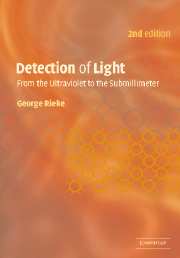Book contents
- Frontmatter
- Contents
- Preface
- 1 Introduction
- 2 Intrinsic photoconductors
- 3 Extrinsic photoconductors
- 4 Photodiodes and other junction-based detectors
- 5 Amplifiers and readouts
- 6 Arrays
- 7 Photoemissive detectors
- 8 Photography
- 9 Bolometers and other thermal detectors
- 10 Visible and infrared coherent receivers
- 11 Submillimeter- and millimeter-wave heterodyne receivers
- 12 Summary
- Appendices
- References
- Index
3 - Extrinsic photoconductors
Published online by Cambridge University Press: 09 November 2009
- Frontmatter
- Contents
- Preface
- 1 Introduction
- 2 Intrinsic photoconductors
- 3 Extrinsic photoconductors
- 4 Photodiodes and other junction-based detectors
- 5 Amplifiers and readouts
- 6 Arrays
- 7 Photoemissive detectors
- 8 Photography
- 9 Bolometers and other thermal detectors
- 10 Visible and infrared coherent receivers
- 11 Submillimeter- and millimeter-wave heterodyne receivers
- 12 Summary
- Appendices
- References
- Index
Summary
As described in the preceding chapter, the spectral response of intrinsic photoconductors is limited to photons that have energies equal to or exceeding the bandgap energy of the detector material. For the high-quality semiconductors silicon and germanium, these energies correspond to maximum wavelengths of 1.1 μm and 1.8 μm, respectively. A number of semiconductor compounds have smaller bandgaps. They are often used as intrinsic photoconductors with rapid time response; however, they are generally unable to achieve the extremely high impedances needed to reduce Johnson noise adequately for very low light levels. In addition, the performance of intrinsic photoconductors degrades rapidly as the wavelength extends beyond about 15 μm due, for example, to poor stability of the materials, difficulties in achieving high uniformity in material properties, and problems in making good electrical contacts to them. Detector operation far into the infrared must therefore be based on some other mechanism. The addition of impurities to a semiconductor allows conductivity to be induced by freeing the impurity-based charge carriers. This extrinsic process can be triggered by lower energies than are required for intrinsic photoconductivity, enabling response at long infrared wavelengths. Because the lower excitation energies also allow for large thermally excited dark currents, these detectors must be operated at low temperatures.
- Type
- Chapter
- Information
- Detection of LightFrom the Ultraviolet to the Submillimeter, pp. 57 - 77Publisher: Cambridge University PressPrint publication year: 2002



